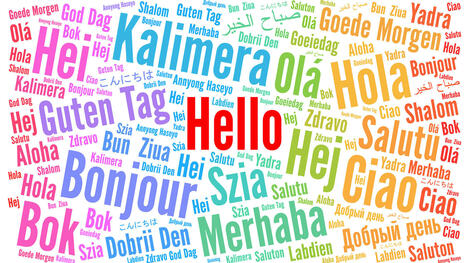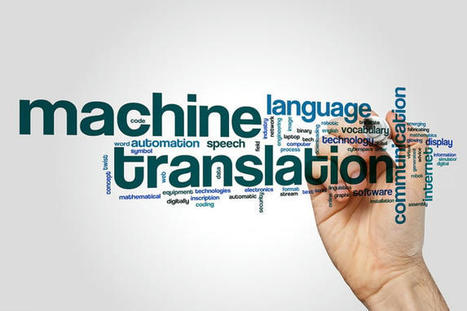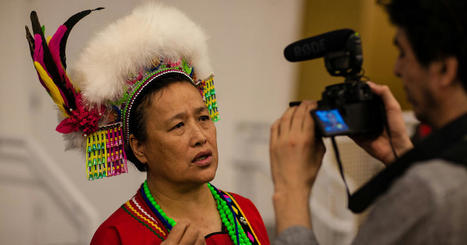The number of people who spoke a language other than English at home nearly tripled from 1980 to 2019, but the number who spoke only English also increased.
Get Started for FREE
Sign up with Facebook Sign up with X
I don't have a Facebook or a X account

 Your new post is loading... Your new post is loading...
 Your new post is loading... Your new post is loading...

Charles Tiayon's curator insight,
November 18, 2023 10:39 PM
"Machine translation (MT) is the process of automatically translating text from one language into another using computer applications. Nov 17 2023 · 10:39 UTC | Updated Nov 17 2023 · 10:42 UTC by John Caroline Machine translation has been very helpful to businesses seeking to improve the way they serve their customers. Let us help you understand all that there is to know about machine translation in this comprehensive guide. Before the inception of remarkable modern technologies, the global market was limited by language barriers which restricted the success of many businesses. While there are diverse languages across the nations of the globe, people from different races and ethnicities often find it difficult to interact with each other and execute certain transactions together, depriving them of several opportunities. Nonetheless, the challenges that come with these language differences have called for the need to build an infrastructure that allows languages to be translated and facilitates the process of communication. This idea has been brought to reality through machine translation (MT) which allows you to leverage computer applications to interpret languages. To help you grasp this concept better, here is a guide that will help you understand machine translation and describe its types, benefits, challenges, and lots more. Machine Translation ExplainedMachine translation can simply be defined as the process of automatically translating text or speech from one language into another using computer applications. The sole aim of this technology is to unify speakers of different languages together, allowing them to seamlessly communicate with each other with little or no barriers. Due to its design, machine translation features a system that takes the text in one language and converts it into another language while keeping the meaning and context as accurate as possible for its audience to understand. It employs advanced algorithms and machine learning to automatically convert text or speech from one language to another. This process generally involves preparing the input text or speech by cleaning and organizing it. Thus, the machine translation system is trained using various examples of texts in multiple languages and their corresponding translations. It learns patterns and probabilities of how words and phrases are translated from these examples. When you input new text for translation, the system uses what it has learned to generate the translation. In some cases, additional adjustments may be made to refine the results if necessary. While the machine translation system is trained via the data inputted into them over time, the data it is using can be either generic data, which is knowledge from all past translations, making them versatile for different applications, or custom data, where specific subject matter expertise is added to the engine, like in engineering or other specialized fields. Users can utilize either of the data depending on their needs. Machine Translation: Brief HistoryThe history of machine translation dates back to the 1950s when early computer scientists attempted to use computing power for language translation. However, the task’s complexity exceeded their expectations, and early machines lacked the necessary processing power and storage. It wasn’t until the early 2000s that software, data, and hardware reached a level where basic machine translation became possible. Developers used statistical language databases to teach computer translation, a process that required considerable manual effort. Notably, the 2010s marked a significant breakthrough with the rise of neural machine translation, introducing deep learning techniques and neural networks to translation models. Google’s “Google Neural Machine Translation” (GNMT) system in 2016 represented a pivotal moment in this technology’s development. Machine Translation TypesWhile the technology behind machine translation systems has advanced significantly in recent years, it has adopted three primary approaches to automatically translate text or speech from one language into another. These approaches include rule-based machine translation (RBMT), statistical machine translation (SMT), and neural machine translation (NMT). Rule-Based Machine Translation (RBMT)Rule-based machine translation (RBMT) was an early approach to translation using predefined linguistic rules. It had low-quality output, required manual addition of languages, and significant human editing. RBMT relies on linguistic experts to create rules for source and target languages, resulting in grammatically accurate but often overly literal translations. While RBMT is precise for languages with strict rules, it struggles with context and nuance, leading to less natural translations. Developing and maintaining rules for various languages is labor-intensive, especially for languages with complex grammar. Additionally, RBMT may struggle with ambiguous phrases or words in the source text. This traditional method is rarely used today due to these limitations. Statistical Machine Translation (SMT)Statistical machine translation (SMT) uses statistical models to understand the relationships between words, phrases, and sentences in a text and then applies this knowledge to translate it into another language. While it’s an improvement over rule-based MT, it still has some of the same issues. SMT is being replaced by neural MT but is occasionally used for older machine translation systems. It stands out from RBMT as it doesn’t rely on predefined rules but learns from large bilingual text collections to make translation decisions. However, SMT has its limitations, such as being reliant on the availability and quality of parallel text data, struggling with context, and potentially generating less fluent or contextually accurate translations, especially for less common phrases. Neural Machine Translation (NMT)Neural machine translation (NMT) represents a modern approach to automated translation, leveraging artificial intelligence to mimic the continuous learning of human neural networks. Unlike older rule-based or statistical methods, NMT’s neural networks are responsible for encoding and decoding the source text. NMT is the prevailing standard in machine translation due to its superior accuracy, scalability to multiple languages, and faster performance once trained. It excels in capturing context and delivering fluent, contextually accurate translations. Nevertheless, NMT does have limitations. Its performance relies on the availability of large, high-quality parallel corpora for training. Additionally, training and deploying NMT models can be computationally intensive, often necessitating powerful hardware like GPUs or TPUs. Automated vs Machine TranslationLet’s clarify the distinction between automated translation and machine translation, as they often get mixed up, however, they perform different roles. Automated translation involves incorporating features into computer-assisted translation tools (CAT tools) or cloud translation management systems (TMS) to automate manual or repetitive translation-related tasks. Its purpose is to streamline the overall translation process, improving efficiency. For instance, automated translation might initiate machine translation for a portion of the text as one of the many steps in a translation workflow. On the other hand, machine translation is all about using software to convert text from one natural language to another without any human involvement, unlike traditional translation. This is why it’s also referred to as automatic translation. Capabilities and ChallengesOver the years, machine translation’s speed and volume capabilities have seen remarkable enhancements due to ongoing improvements in machine learning algorithms and hardware technology. It can now translate millions of words almost instantaneously and continues to get better as more content is translated. For high-volume projects, MT not only handles volume at speed but can also integrate with other software platforms like content or translation management systems to maintain organization and context during translation. Moreover, MT’s improved accessibility, offering translations in multiple languages, benefits both businesses and customers by eliminating language barriers and enhancing the customer experience. This expansion to a wider audience helps businesses grow their market share. Another advantage of MT is cost reduction. While human translators still play a role in refining translations to match the original content’s intent and localize it per region, MT does the initial heavy lifting, saving time and costs, even when post-editing by human translators is involved. Nonetheless, while machine translation is a cost-effective and quick solution for global expansion, it’s important to recognize the challenges it presents. These challenges include:
Future of Machine Translation: Will It Replace Humans?Translation technology has made significant advancements, but it’s unlikely to completely replace human translators. While machine translation tools like neural machine translation (NMT) are proficient in handling straightforward, repetitive tasks and providing quick translations, they still struggle with context, nuance, and understanding the cultural and linguistic subtleties that human translators excel at. Human translators bring cultural and contextual insights to their work, ensuring that translations are accurate, idiomatic, and sensitive to the nuances of the source and target languages. They are indispensable in complex or specialized fields like legal, medical, or creative content, where precise and culturally appropriate translations are critical. Machine Translation EnginesThe main providers of generic machine translation engines include Google Translate, Microsoft Translator, DeepL, and IBM Language Translator. These providers offer pre-trained models for a wide range of languages and general translation needs. For custom machine translation engines, there are specialized companies like Lilt and Iconic Translation Machines that offer tailored solutions for specific industries or organizations. Final ThoughtsMachine translation (MT) has added lots of value to the global space, eradicating barriers to language differences while allowing people to seamlessly access translations to languages they do not understand. While this has greatly impacted businesses worldwide, especially those that hold international deals, it has also impacted the social life of many as it tends to strengthen relationships among people of different languages. As this technology continues to evolve, the world will soon overcome every limitation that tends to come with language barriers using efficient computer tools." #metaglossia_mundus 
Charles Tiayon's curator insight,
November 18, 2023 10:53 PM
"Machine translation (MT) is the process of automatically translating text from one language into another using computer applications. Nov 17 2023 · 10:39 UTC | Updated Nov 17 2023 · 10:42 UTC by John Caroline Machine translation has been very helpful to businesses seeking to improve the way they serve their customers. Let us help you understand all that there is to know about machine translation in this comprehensive guide. Before the inception of remarkable modern technologies, the global market was limited by language barriers which restricted the success of many businesses. While there are diverse languages across the nations of the globe, people from different races and ethnicities often find it difficult to interact with each other and execute certain transactions together, depriving them of several opportunities. Nonetheless, the challenges that come with these language differences have called for the need to build an infrastructure that allows languages to be translated and facilitates the process of communication. This idea has been brought to reality through machine translation (MT) which allows you to leverage computer applications to interpret languages. To help you grasp this concept better, here is a guide that will help you understand machine translation and describe its types, benefits, challenges, and lots more. Machine Translation ExplainedMachine translation can simply be defined as the process of automatically translating text or speech from one language into another using computer applications. The sole aim of this technology is to unify speakers of different languages together, allowing them to seamlessly communicate with each other with little or no barriers. Due to its design, machine translation features a system that takes the text in one language and converts it into another language while keeping the meaning and context as accurate as possible for its audience to understand. It employs advanced algorithms and machine learning to automatically convert text or speech from one language to another. This process generally involves preparing the input text or speech by cleaning and organizing it. Thus, the machine translation system is trained using various examples of texts in multiple languages and their corresponding translations. It learns patterns and probabilities of how words and phrases are translated from these examples. When you input new text for translation, the system uses what it has learned to generate the translation. In some cases, additional adjustments may be made to refine the results if necessary. While the machine translation system is trained via the data inputted into them over time, the data it is using can be either generic data, which is knowledge from all past translations, making them versatile for different applications, or custom data, where specific subject matter expertise is added to the engine, like in engineering or other specialized fields. Users can utilize either of the data depending on their needs. Machine Translation: Brief HistoryThe history of machine translation dates back to the 1950s when early computer scientists attempted to use computing power for language translation. However, the task’s complexity exceeded their expectations, and early machines lacked the necessary processing power and storage. It wasn’t until the early 2000s that software, data, and hardware reached a level where basic machine translation became possible. Developers used statistical language databases to teach computer translation, a process that required considerable manual effort. Notably, the 2010s marked a significant breakthrough with the rise of neural machine translation, introducing deep learning techniques and neural networks to translation models. Google’s “Google Neural Machine Translation” (GNMT) system in 2016 represented a pivotal moment in this technology’s development. Machine Translation TypesWhile the technology behind machine translation systems has advanced significantly in recent years, it has adopted three primary approaches to automatically translate text or speech from one language into another. These approaches include rule-based machine translation (RBMT), statistical machine translation (SMT), and neural machine translation (NMT). Rule-Based Machine Translation (RBMT)Rule-based machine translation (RBMT) was an early approach to translation using predefined linguistic rules. It had low-quality output, required manual addition of languages, and significant human editing. RBMT relies on linguistic experts to create rules for source and target languages, resulting in grammatically accurate but often overly literal translations. While RBMT is precise for languages with strict rules, it struggles with context and nuance, leading to less natural translations. Developing and maintaining rules for various languages is labor-intensive, especially for languages with complex grammar. Additionally, RBMT may struggle with ambiguous phrases or words in the source text. This traditional method is rarely used today due to these limitations. Statistical Machine Translation (SMT)Statistical machine translation (SMT) uses statistical models to understand the relationships between words, phrases, and sentences in a text and then applies this knowledge to translate it into another language. While it’s an improvement over rule-based MT, it still has some of the same issues. SMT is being replaced by neural MT but is occasionally used for older machine translation systems. It stands out from RBMT as it doesn’t rely on predefined rules but learns from large bilingual text collections to make translation decisions. However, SMT has its limitations, such as being reliant on the availability and quality of parallel text data, struggling with context, and potentially generating less fluent or contextually accurate translations, especially for less common phrases. Neural Machine Translation (NMT)Neural machine translation (NMT) represents a modern approach to automated translation, leveraging artificial intelligence to mimic the continuous learning of human neural networks. Unlike older rule-based or statistical methods, NMT’s neural networks are responsible for encoding and decoding the source text. NMT is the prevailing standard in machine translation due to its superior accuracy, scalability to multiple languages, and faster performance once trained. It excels in capturing context and delivering fluent, contextually accurate translations. Nevertheless, NMT does have limitations. Its performance relies on the availability of large, high-quality parallel corpora for training. Additionally, training and deploying NMT models can be computationally intensive, often necessitating powerful hardware like GPUs or TPUs. Automated vs Machine TranslationLet’s clarify the distinction between automated translation and machine translation, as they often get mixed up, however, they perform different roles. Automated translation involves incorporating features into computer-assisted translation tools (CAT tools) or cloud translation management systems (TMS) to automate manual or repetitive translation-related tasks. Its purpose is to streamline the overall translation process, improving efficiency. For instance, automated translation might initiate machine translation for a portion of the text as one of the many steps in a translation workflow. On the other hand, machine translation is all about using software to convert text from one natural language to another without any human involvement, unlike traditional translation. This is why it’s also referred to as automatic translation. Capabilities and ChallengesOver the years, machine translation’s speed and volume capabilities have seen remarkable enhancements due to ongoing improvements in machine learning algorithms and hardware technology. It can now translate millions of words almost instantaneously and continues to get better as more content is translated. For high-volume projects, MT not only handles volume at speed but can also integrate with other software platforms like content or translation management systems to maintain organization and context during translation. Moreover, MT’s improved accessibility, offering translations in multiple languages, benefits both businesses and customers by eliminating language barriers and enhancing the customer experience. This expansion to a wider audience helps businesses grow their market share. Another advantage of MT is cost reduction. While human translators still play a role in refining translations to match the original content’s intent and localize it per region, MT does the initial heavy lifting, saving time and costs, even when post-editing by human translators is involved. Nonetheless, while machine translation is a cost-effective and quick solution for global expansion, it’s important to recognize the challenges it presents. These challenges include:
Future of Machine Translation: Will It Replace Humans?Translation technology has made significant advancements, but it’s unlikely to completely replace human translators. While machine translation tools like neural machine translation (NMT) are proficient in handling straightforward, repetitive tasks and providing quick translations, they still struggle with context, nuance, and understanding the cultural and linguistic subtleties that human translators excel at. Human translators bring cultural and contextual insights to their work, ensuring that translations are accurate, idiomatic, and sensitive to the nuances of the source and target languages. They are indispensable in complex or specialized fields like legal, medical, or creative content, where precise and culturally appropriate translations are critical. Machine Translation EnginesThe main providers of generic machine translation engines include Google Translate, Microsoft Translator, DeepL, and IBM Language Translator. These providers offer pre-trained models for a wide range of languages and general translation needs. For custom machine translation engines, there are specialized companies like Lilt and Iconic Translation Machines that offer tailored solutions for specific industries or organizations. Final ThoughtsMachine translation (MT) has added lots of value to the global space, eradicating barriers to language differences while allowing people to seamlessly access translations to languages they do not understand. While this has greatly impacted businesses worldwide, especially those that hold international deals, it has also impacted the social life of many as it tends to strengthen relationships among people of different languages. As this technology continues to evolve, the world will soon overcome every limitation that tends to come with language barriers using efficient computer tools." #metaglossia_mundus

Charles Tiayon's curator insight,
April 28, 2024 12:16 AM
"A new Tamil e-dictionary app that includes some 50,000 words could also be used by students for their examinations in the future. 25 Apr 2024 16:32 | Updated at: 26 Apr 2024 05:30 | 4 mins read A new Tamil e-dictionary app that includes some 50,000 words could also be used by students for their examinations in the future. Inspired by the handy dictionary devices used in Malay and Chinese exams, the new “The Agaram” Tamil e-dictionary app was conceptualised and tailored to the needs of Tamil-speaking students in Singapore. Unveiled on April 21 at the Umar Pulavar Tamil Language Centre, the app marks a significant stride in bridging the gap between traditional learning and digital innovation, ensuring Tamil’s accessibility and relevance to modern learners, said Mr Shahul Hameed, business development manager of Cosmic Consultancy, the company that launched the app. With support from the Lee Kuan Yew Fund for Bilingualism, a team led by local poet S. Thinnappan helped developed the app in a collaborative effort which included contributions from various academics. The team ensured the app’s effectiveness in nurturing linguistic proficiency among students, said Mr Hameed, adding that “the Agaram e-Dictionary is more than just a linguistic tool, it’s a gateway to empowerment”. Discussions are underway with the Singapore Examinations and Assessment Board to integrate the app into formal education systems, Mr Hameed noted. The app comprises some 50,000 Tamil words used in the Singaporean context, with its English translations, accurate audio pronunciation guides and grammatical contexts. Along with visual aids, the app also shows examples of how to use a word in a sentence. Mr Anbarasu Rajendran, CEO of the Singapore Indian Development Association, who was the guest of honour at the unveiling event, said he appreciated the efforts of the team and highlighted the importance of Tamil language learning and the app’s potential to enrich students’ language skills. Aishwarya, a student at Crescent Girls School, said: “While writing an essay, we tend to think of words in English. Tamil is an extensive language with 247 letters, it is difficult to find a synonym of a word in a big dictionary. By typing the English word in this app, the synonym appears quickly.” Rather than worrying about words, students can now focus on developing creativity and imagination, she added. Mr Hameed revealed plans to enhance the app’s functionality by incorporating features such as the thesaurus and lexicons. Accessible via www.minagaram.com, the Agaram e-dictionary app is also available on the Apple app store. It will be available for Android users on Google Play Store in the future. “The Agaram e-Dictionary is more than just a linguistic tool, it’s a gateway to empowerment.” " #metaglossia_mundus 
Charles Tiayon's curator insight,
April 28, 2024 12:17 AM
"A new Tamil e-dictionary app that includes some 50,000 words could also be used by students for their examinations in the future. 25 Apr 2024 16:32 | Updated at: 26 Apr 2024 05:30 | 4 mins read A new Tamil e-dictionary app that includes some 50,000 words could also be used by students for their examinations in the future. Inspired by the handy dictionary devices used in Malay and Chinese exams, the new “The Agaram” Tamil e-dictionary app was conceptualised and tailored to the needs of Tamil-speaking students in Singapore. Unveiled on April 21 at the Umar Pulavar Tamil Language Centre, the app marks a significant stride in bridging the gap between traditional learning and digital innovation, ensuring Tamil’s accessibility and relevance to modern learners, said Mr Shahul Hameed, business development manager of Cosmic Consultancy, the company that launched the app. With support from the Lee Kuan Yew Fund for Bilingualism, a team led by local poet S. Thinnappan helped developed the app in a collaborative effort which included contributions from various academics. The team ensured the app’s effectiveness in nurturing linguistic proficiency among students, said Mr Hameed, adding that “the Agaram e-Dictionary is more than just a linguistic tool, it’s a gateway to empowerment”. Discussions are underway with the Singapore Examinations and Assessment Board to integrate the app into formal education systems, Mr Hameed noted. The app comprises some 50,000 Tamil words used in the Singaporean context, with its English translations, accurate audio pronunciation guides and grammatical contexts. Along with visual aids, the app also shows examples of how to use a word in a sentence. Mr Anbarasu Rajendran, CEO of the Singapore Indian Development Association, who was the guest of honour at the unveiling event, said he appreciated the efforts of the team and highlighted the importance of Tamil language learning and the app’s potential to enrich students’ language skills. Aishwarya, a student at Crescent Girls School, said: “While writing an essay, we tend to think of words in English. Tamil is an extensive language with 247 letters, it is difficult to find a synonym of a word in a big dictionary. By typing the English word in this app, the synonym appears quickly.” Rather than worrying about words, students can now focus on developing creativity and imagination, she added. Mr Hameed revealed plans to enhance the app’s functionality by incorporating features such as the thesaurus and lexicons. Accessible via www.minagaram.com, the Agaram e-dictionary app is also available on the Apple app store. It will be available for Android users on Google Play Store in the future. “The Agaram e-Dictionary is more than just a linguistic tool, it’s a gateway to empowerment.” " #metaglossia_mundus 
Charles Tiayon's curator insight,
April 28, 2024 12:17 AM
"A new Tamil e-dictionary app that includes some 50,000 words could also be used by students for their examinations in the future. 25 Apr 2024 16:32 | Updated at: 26 Apr 2024 05:30 | 4 mins read A new Tamil e-dictionary app that includes some 50,000 words could also be used by students for their examinations in the future. Inspired by the handy dictionary devices used in Malay and Chinese exams, the new “The Agaram” Tamil e-dictionary app was conceptualised and tailored to the needs of Tamil-speaking students in Singapore. Unveiled on April 21 at the Umar Pulavar Tamil Language Centre, the app marks a significant stride in bridging the gap between traditional learning and digital innovation, ensuring Tamil’s accessibility and relevance to modern learners, said Mr Shahul Hameed, business development manager of Cosmic Consultancy, the company that launched the app. With support from the Lee Kuan Yew Fund for Bilingualism, a team led by local poet S. Thinnappan helped developed the app in a collaborative effort which included contributions from various academics. The team ensured the app’s effectiveness in nurturing linguistic proficiency among students, said Mr Hameed, adding that “the Agaram e-Dictionary is more than just a linguistic tool, it’s a gateway to empowerment”. Discussions are underway with the Singapore Examinations and Assessment Board to integrate the app into formal education systems, Mr Hameed noted. The app comprises some 50,000 Tamil words used in the Singaporean context, with its English translations, accurate audio pronunciation guides and grammatical contexts. Along with visual aids, the app also shows examples of how to use a word in a sentence. Mr Anbarasu Rajendran, CEO of the Singapore Indian Development Association, who was the guest of honour at the unveiling event, said he appreciated the efforts of the team and highlighted the importance of Tamil language learning and the app’s potential to enrich students’ language skills. Aishwarya, a student at Crescent Girls School, said: “While writing an essay, we tend to think of words in English. Tamil is an extensive language with 247 letters, it is difficult to find a synonym of a word in a big dictionary. By typing the English word in this app, the synonym appears quickly.” Rather than worrying about words, students can now focus on developing creativity and imagination, she added. Mr Hameed revealed plans to enhance the app’s functionality by incorporating features such as the thesaurus and lexicons. Accessible via www.minagaram.com, the Agaram e-dictionary app is also available on the Apple app store. It will be available for Android users on Google Play Store in the future. “The Agaram e-Dictionary is more than just a linguistic tool, it’s a gateway to empowerment.” " #metaglossia_mundus

Charles Tiayon's curator insight,
June 1, 2024 12:43 AM
"Sealaska Heritage Institute has published a trilogy of illustrated dictionaries in Tlingit, Haida, and Tsimshian languages in efforts to help preserve some of Alaska's native languages." #metaglossia_mundus 
Charles Tiayon's curator insight,
June 1, 2024 12:44 AM
"Sealaska Heritage Institute has published a trilogy of illustrated dictionaries in Tlingit, Haida, and Tsimshian languages in efforts to help preserve some of Alaska's native languages." #metaglossia_mundus 
Charles Tiayon's curator insight,
June 1, 2024 12:45 AM
"Sealaska Heritage Institute has published a trilogy of illustrated dictionaries in Tlingit, Haida, and Tsimshian languages in efforts to help preserve some of Alaska's native languages." #metaglossia_mundus |

Charles Tiayon's curator insight,
May 24, 2022 1:14 AM
"The neat thing about linguistic diversity (and our guides) is that it extends beyond language. Since language is a gateway to a world of expressions, values and unspoken sentiments, its power stems from much that is unspoken. We started with six languages, offering a way for communities to feel excited about the beauty their languages bring to the Ontario mosaic. By distributing them to restaurants like Naan & Chai in Ajax and Aunty’s Kitchen in Mississauga, we are motivating people to interact with the elections in languages and places they connect with. Just as environmental diversity and protection are critical elements of what makes Ontario thrive, its linguistic diversity must also be recognized and reflected to get people to register and vote. This is why we hope others will also work in multiple languages this election season. We have an entire province that is ready to listen, in about 200 languages. Zabaan dil se suni jaati hai, bolnay say nahi. “Language is heard by the heart, not solely by speaking.” Maham Kaleem is an elections campaigner for the David Suzuki Foundation." #metaglossia mundus

Charles Tiayon's curator insight,
October 30, 2024 1:15 AM
Google has announced the addition of 15 more African languages to Voice Search, Gboard talk-to-type, and Translate dictation, allowing approximately 300 million more Africans to interact with the web using their voices. to support AI skilling and education across sub-Saharan Africa. The funds will be used to provide foundational AI and cybersecurity skills to workers and students and support nonprofit leaders and the public sector in developing these skills. support for organisations helping Africans develop digital skills from Google's economic opportunity initiative, ” Google added.

EDTECH@UTRGV's curator insight,
October 24, 2024 12:14 PM
"This study provides evidence that the incorporation of immersive VR instruction may create a space for visual- and gestural-focused meaning-making, which contributes to both [multilingual learners] and [English monolingual learners’] development of disciplinary literacy in science"
Tanja Elbaz's curator insight,
December 25, 2023 10:34 AM
health care pharmacy's curator insight,
March 27, 2024 7:08 AM
<a href="https://farmaciadimagrante.com/Prodotto/acquista-mysimba-online/">acquista-mysimba-online</a>;
https://globaalapotheek.com/product/koop-adderall-online/
health care pharmacy's curator insight,
March 27, 2024 8:11 AM
<a href="https://farmaciadimagrante.com/Prodotto/acquista-mysimba-online/">acquista-mysimba-online</a>;
https://globaalapotheek.com/product/koop-adderall-online/

Charles Tiayon's curator insight,
May 10, 2024 9:47 PM
"May 10, 2024, Friday // 16:00 The official spelling and grammar dictionary of the Bulgarian language has been launched online for the first time, thanks to the BERON platform developed by the Bulgarian Academy of Science (BAS). Published periodically by the Bulgarian Language Institute at the Bulgarian Academy of Sciences, this dictionary establishes norms in Bulgarian language usage and is regarded as the authority on proper speech and spelling. Introduced at the Bulgarian Academy of Sciences (BAS), the BERON platform falls under the Ministry of Education's domain. The timing of its unveiling was deliberate, being the day following Europe Day and preceding May 11, the feast day of Cyril and Methodius in the old calendar. BERON offers users the ability to both hear and see word characteristics. For instance, for each verb, users can access conjugations, forms across different verb tenses, and other relevant features. With approximately 2,400,000 forms, the platform serves as a comprehensive reference for spelling, grammar, legal language, and information on homonyms and doublets. It provides free, reliable access to information on the Bulgarian literary language, including a "Question of the Day" section, addressing inquiries frequently received by the Language Reference and Consultation Service of the Institute of the Bulgarian Language. Prof. Dr. Ruska Stancheva spearheaded the creation of the BERON project, naming it in honor of Dr. Peter Beron. The acronym BERON stands for "Bulgarian Language Resources Online" (Български езикови ресурси онлайн). Prof. Stancheva highlighted the importance of Beron's primer in shaping the Bulgarian literary language's rules, emphasizing the platform's aim to disseminate knowledge and assist people in their daily lives. The pronunciation of words on the platform is provided by actress Gergana Stoyanova, and a mobile version of the dictionary is also available." #metaglossia_mundus: https://www.novinite.com/articles/226022/Inaugural+Online+Edition%3A+Bulgarian+Language+Dictionary+Unveiled

Charles Tiayon's curator insight,
May 10, 2024 9:48 PM
"May 10, 2024, Friday // 16:00 The official spelling and grammar dictionary of the Bulgarian language has been launched online for the first time, thanks to the BERON platform developed by the Bulgarian Academy of Science (BAS). Published periodically by the Bulgarian Language Institute at the Bulgarian Academy of Sciences, this dictionary establishes norms in Bulgarian language usage and is regarded as the authority on proper speech and spelling. Introduced at the Bulgarian Academy of Sciences (BAS), the BERON platform falls under the Ministry of Education's domain. The timing of its unveiling was deliberate, being the day following Europe Day and preceding May 11, the feast day of Cyril and Methodius in the old calendar. BERON offers users the ability to both hear and see word characteristics. For instance, for each verb, users can access conjugations, forms across different verb tenses, and other relevant features. With approximately 2,400,000 forms, the platform serves as a comprehensive reference for spelling, grammar, legal language, and information on homonyms and doublets. It provides free, reliable access to information on the Bulgarian literary language, including a "Question of the Day" section, addressing inquiries frequently received by the Language Reference and Consultation Service of the Institute of the Bulgarian Language. Prof. Dr. Ruska Stancheva spearheaded the creation of the BERON project, naming it in honor of Dr. Peter Beron. The acronym BERON stands for "Bulgarian Language Resources Online" (Български езикови ресурси онлайн). Prof. Stancheva highlighted the importance of Beron's primer in shaping the Bulgarian literary language's rules, emphasizing the platform's aim to disseminate knowledge and assist people in their daily lives. The pronunciation of words on the platform is provided by actress Gergana Stoyanova, and a mobile version of the dictionary is also available." #metaglossia_mundus: https://www.novinite.com/articles/226022/Inaugural+Online+Edition%3A+Bulgarian+Language+Dictionary+Unveiled

Charles Tiayon's curator insight,
May 10, 2024 9:49 PM
"May 10, 2024, Friday // 16:00 The official spelling and grammar dictionary of the Bulgarian language has been launched online for the first time, thanks to the BERON platform developed by the Bulgarian Academy of Science (BAS). Published periodically by the Bulgarian Language Institute at the Bulgarian Academy of Sciences, this dictionary establishes norms in Bulgarian language usage and is regarded as the authority on proper speech and spelling. Introduced at the Bulgarian Academy of Sciences (BAS), the BERON platform falls under the Ministry of Education's domain. The timing of its unveiling was deliberate, being the day following Europe Day and preceding May 11, the feast day of Cyril and Methodius in the old calendar. BERON offers users the ability to both hear and see word characteristics. For instance, for each verb, users can access conjugations, forms across different verb tenses, and other relevant features. With approximately 2,400,000 forms, the platform serves as a comprehensive reference for spelling, grammar, legal language, and information on homonyms and doublets. It provides free, reliable access to information on the Bulgarian literary language, including a "Question of the Day" section, addressing inquiries frequently received by the Language Reference and Consultation Service of the Institute of the Bulgarian Language. Prof. Dr. Ruska Stancheva spearheaded the creation of the BERON project, naming it in honor of Dr. Peter Beron. The acronym BERON stands for "Bulgarian Language Resources Online" (Български езикови ресурси онлайн). Prof. Stancheva highlighted the importance of Beron's primer in shaping the Bulgarian literary language's rules, emphasizing the platform's aim to disseminate knowledge and assist people in their daily lives. The pronunciation of words on the platform is provided by actress Gergana Stoyanova, and a mobile version of the dictionary is also available." #metaglossia_mundus: https://www.novinite.com/articles/226022/Inaugural+Online+Edition%3A+Bulgarian+Language+Dictionary+Unveiled

Charles Tiayon's curator insight,
July 31, 2024 12:54 AM
"The full extent of Southeast Asia's cultural diversity risks being ignored by AI models built on English and Mandarin Chinese. AI can help bridge Southeast Asia’s 1,000 languages—but the work ‘has to be done by Southeast Asians’ BYDAVID AUSTIN July 30, 2024 at 2:53 PM GMT+1 “AI models are built on data…and the region is not well represented in the digital space," said Leslie Teo, lead on the Southeast Asian Languages in One Network (Sea-Lion) project. GRAHAM UDEN FOR FORTUNE With over 1,000 languages, Southeast Asia is one of the most linguistically diverse regions in the world—and that’s a challenge for businesses trying to operate with talent and customers right next door. “The language barrier can be a huge issue,” Kisson Lin, co-founder and chief operating officer for Singaporean AI startup Mindverse AI at the Fortune Brainstorm AI Singapore conference on Tuesday. “We have different colleagues from different regions speaking different languages. It’s not only that you [find] it hard to collaborate, but also hard to bond with each other.” But can AI bridge the linguistic divide, without eradicating the cultural nuances within a diverse population of 600 million? Solving this question can unlock new markets for global businesses. Lin pointed out that Alibaba’s sales revenue spiked once it started using AI to translate product information. AI might even help India’s prolific, multilingual entertainment industry “propagate to the whole world,” says Sambit Sahu, senior vice president of silicon design for Ola Kutrim, an Indian AI startup. Yet Leslie Teo, lead of the Southeast Asian Languages in One Network (Sea-Lion) project, said that hundreds of Southeast Asian languages present a unique challenge to developers. “AI models are built on data…and the region is not well represented in the digital space.” That means the richness of the area’s food, history, and culture—particularly from smaller language groups like Khmer and Lao—risks being left out. The benchmarks for judging AI’s performance are also largely driven by English and Mandarin Chinese..." #metaglossia_mundus: https://fortune.com/asia/2024/07/30/ai-can-help-bridge-southeast-asia-one-thousand-languages-culture-diversity-brainstorm-ai-singapore/ 
Charles Tiayon's curator insight,
August 1, 2024 11:39 PM
"The full extent of Southeast Asia's cultural diversity risks being ignored by AI models built on English and Mandarin Chinese. AI can help bridge Southeast Asia’s 1,000 languages—but the work ‘has to be done by Southeast Asians’ BYDAVID AUSTIN July 30, 2024 at 2:53 PM GMT+1 “AI models are built on data…and the region is not well represented in the digital space," said Leslie Teo, lead on the Southeast Asian Languages in One Network (Sea-Lion) project. GRAHAM UDEN FOR FORTUNE With over 1,000 languages, Southeast Asia is one of the most linguistically diverse regions in the world—and that’s a challenge for businesses trying to operate with talent and customers right next door. “The language barrier can be a huge issue,” Kisson Lin, co-founder and chief operating officer for Singaporean AI startup Mindverse AI at the Fortune Brainstorm AI Singapore conference on Tuesday. “We have different colleagues from different regions speaking different languages. It’s not only that you [find] it hard to collaborate, but also hard to bond with each other.” But can AI bridge the linguistic divide, without eradicating the cultural nuances within a diverse population of 600 million? Solving this question can unlock new markets for global businesses. Lin pointed out that Alibaba’s sales revenue spiked once it started using AI to translate product information. AI might even help India’s prolific, multilingual entertainment industry “propagate to the whole world,” says Sambit Sahu, senior vice president of silicon design for Ola Kutrim, an Indian AI startup. Yet Leslie Teo, lead of the Southeast Asian Languages in One Network (Sea-Lion) project, said that hundreds of Southeast Asian languages present a unique challenge to developers. “AI models are built on data…and the region is not well represented in the digital space.” That means the richness of the area’s food, history, and culture—particularly from smaller language groups like Khmer and Lao—risks being left out. The benchmarks for judging AI’s performance are also largely driven by English and Mandarin Chinese..." #metaglossia_mundus: https://fortune.com/asia/2024/07/30/ai-can-help-bridge-southeast-asia-one-thousand-languages-culture-diversity-brainstorm-ai-singapore/ |






























